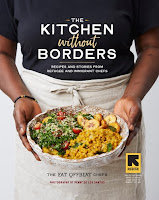Author: The Eat Offbeat Chefs,
Publication Information: Workman Publishing Company. 2021. 232 pages.
ISBN: 1523504048 / 978-1523504046
Book Source: I received this book through NetGalley free of cost in exchange for an honest review.
Opening Sentence: "This story starts like so many other cooking stories - with a grandmother's recipe."
Favorite Quote: "And so it was for the variety of countries that people fled, looking for a better life, often leaving everything behind except for their beautiful memories immortalized in the recipes they brought along with them. These tasty dishes represent cultures where cooking is valued as an act of love for your family, not just an elevated art that professionals practice in restaurant."
Eat Offbeat begins with Manal Kahi's story. Manal Kahi came to New York City in 2013. With her, she brought the food and heritage of her culture. From New York City, her adopted home, comes the opportunity of new beginnings. It began with her grandmother's hummus recipe that friends so liked and recommended that she sell. With that was born the idea of all the refugees and immigrants settled in New York City representing themselves through food. The result is Eat Offbeats. The company provides catering, featuring the food from the contributing chefs from around the world.
The publication of this book is also being done in partnership with the International Rescue Committee (IRC). In fact, from May 15, 2020, to May 15, 2021, (including any preordered copies that ship during this period), Workman Publishing will donate 2% of the cover price for every copy of The Kitchen without Borders cookbook sold in the United States and its territories, the United Kingdom, Canada, Australia and European Union member states, to the IRC, a not-for-profit organization dedicated to providing humanitarian aid, relief and resettlement to refugees and other victims of oppression or violent conflict, with a minimum contribution of $25,000 USD.
Eat Offbeat begins with Manal Kahi's story. Manal Kahi came to New York City in 2013. With her, she brought the food and heritage of her culture. From New York City, her adopted home, comes the opportunity of new beginnings. It began with her grandmother's hummus recipe that friends so liked and recommended that she sell. With that was born the idea of all the refugees and immigrants settled in New York City representing themselves through food. The result is Eat Offbeats. The company provides catering, featuring the food from the contributing chefs from around the world.
The current cadre of chefs represents refugees and immigrants from Venezuela, Iran, Sri Lanka, Afghanistan, Guinea, Syria, and Iraq. This book is a representation of the melting pot of New York City with not only recipes but also the stories of the Eat Offbeat chefs. While the food may not be familiar to some readers, all will relate to the idea that the smell or taste of even the idea of a dish can bring to mind memories. It is these stories that bring the recipes of this book to life as they do in The Hot Bread Kitchen Cookbook, another New York City enterprise that seeks to highlight the diversity of our community.
The book is organized into typical sections you might find in a cookbook - appetizers and dips, salads and soups, rice and grains, vegetarian dishes, meat dishes, and desserts and drinks. The beginning of each section provides a list of recipes with the culturally correct name and then a brief description of the dish itself. The ingredients and methodology is clearly laid out, and several include a picture of the dish. I love being able to see the end product.
The book also contains a "pantry" section describing some of the international ingredients that may be less familiar to some readers. Also provided are conversion tables between different measurement systems - Fahrenheit to Celsius and US imperial to metric. The chefs have also provided recommended pairings and menus to assemble the dishes into a complete meal. Finally, the book is expected to contain an index which is not in this review copy. All these features make a cookbook easier to navigate and more user friendly.
My favorite part of the book is the stories and pictures of the chefs. Each tells of their relationship with food and how and why they came to their adopted home of New York City. The personal stories of these family recipes makes them truly special.
My favorite part of the book is the stories and pictures of the chefs. Each tells of their relationship with food and how and why they came to their adopted home of New York City. The personal stories of these family recipes makes them truly special.
The publication of this book is also being done in partnership with the International Rescue Committee (IRC). In fact, from May 15, 2020, to May 15, 2021, (including any preordered copies that ship during this period), Workman Publishing will donate 2% of the cover price for every copy of The Kitchen without Borders cookbook sold in the United States and its territories, the United Kingdom, Canada, Australia and European Union member states, to the IRC, a not-for-profit organization dedicated to providing humanitarian aid, relief and resettlement to refugees and other victims of oppression or violent conflict, with a minimum contribution of $25,000 USD.
Please share your thoughts and leave a comment. I would love to "talk" to you.







